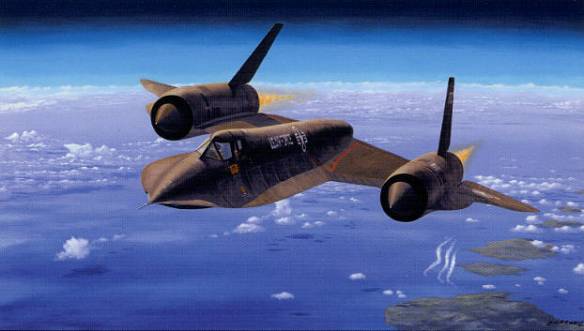The SR-71 called Habu 972 takes a look at the Kamchatka Peninsula, while three MiG-25’s, lower right, make a futile, hopeless attempt to intercept.
In the Cold War the SR-71 missions were no secret. When SR-71 arrived in Mildenhall/UK det. 4 from Beale/USA this went not unnoticed and was phoned to Moscow. The engines were started 40 minutes before take-off. This was phoned to Moscow too. When climbing up over the North Sea, it was spotted by alerted Russian recce trawlers there. 7 minutes after start the SR-71 reached KC-135Q for topping-up.
Than the SR-71 started the typical “Dipsy” manouver to overcome the transonic-range, before climbing with a constant KEAS to ~ 80000 feet.
When SR-71s arrived in the UK some MiG-25s in the GDR were put on alert readiness.
Similar the alert status of interceptors units alongside known SR-71 recce-runs were risen. When the SR-71 started its engines, similar was done at the alerted ABs. At a given height and speed the SR-71 becomes a unique spot on every radar. Flying at Mach 3+ its flight was a straight line and the main direction of interest no longer a secret. In reality the Russian trained high-speed intercepts against a high and fast target. During the “Baltic-run” the SR-71 and MiG-25 came very close in a confined airspace between Denmark and the GDR, when the MiG-25 zoom-climbed behind the SR-71 for a single fire solution by that. For the USA it was more interesting to learn, what sensors were shut down before an imminent SR-71 fly-by. The SR-71 route was chosen to keep it outside the danger-zone, which was vastly reduced by the flight-level and speed of the SR-71.
Those “Peace-time operations” had nothing to do with “War-time operations”, when the SR-71 would have passed over Sweden to avoid such interception attempts.
When in the European theatre the national borders were respected, the situation looked different at the polar-circle. Flying into the Kara Sea for example was still international airspace, while the Russians saw it as their personal backyard. First naval units with SA-N-6 and MiG-31s with new intercept capabilities brought an end of those incursions. Too risky without third-party observers any longer.
Mig-25 defector Viktor Belenko “left the service” before seeing the R-40TD long range heat seeker (which is still carried by Mig-31s today as a very long range IR missile), which had plenty of speed (Mach 4.5) and a perfect target (A friction heated lump of Ti surrounded by a large cold sky). You have to remember that the SR-71 was detected by Chinese radars when it took off for overflights of South and North Vietnam… it was no stealth plane. With plenty of warning (and no ID problems… not many other aircraft flew at that height or speed) Interception would not have been that hard. With SA-5s well able to reach its height and Mig-25s able to fly very high too the SR-71s would have had a very difficult time of things. With the introduction of the S-300 and S-300V series SAMs (SA-10 and SA-12) and the introduction of the Mig-31 it wouldn’t have a chance.
Jane’s Fighter Combat in the Jet Age page 116-117 “SR71 the Ultimate Target”. June 3, 1986 an SR was on a mission over the Barents Sea. “Six Mig 31 Foxhounds, vastly superior to the Mig25 Foxbat, performed a coordinated intercept that would have subjected the SR71 to an all-angle AAM attack that even a combination of high-altitude maneuverability and ECM could not have defeated. Fortunately for the American jet, the interception took place over international waters, but the Soviets proved their point.”
The SR-71 and MiG-25 are both limited by temperature at first.
The SR-71 is red-lined at Mach 3.2 and the MiG-25 at Mach 2,83.
The SR-71 travels with Mach 3-3.2 up to 90 minutes.
The MiG-25 travels with Mach 2.35 up to 40 minutes. Mach 2.6 possible but limited to 20 minutes. Mach 2.83 is the dash-speed for a few minutes only.
Both aircraft could pass the red line, for the SR-71 it was Mach 3.5 and for the MiG-25 it was Mach 3+, but doing so outside the safe envelope by that.
The Ye-266/Ye-266M were tweaked with some more heat-resistant material in certain areas and limited to essential avionics only.
R.A. Belyakov MiG p 194 gives range on int. fuel for MiG-25P at supersonic speed 1250 km (=
[1730:125= 830.4 km/h average) translates into Mach 0.85 or 910 km/h at travel-height.
The MiG-25R (p 401) supersonic = 1635 km and subsonic = 1865 km with 5300 litre auxiliary fuel tank the values became 2130 km supersonic and 2400 km subsonic. (Mach 2.35 and Mach 0.85)
All MiG-25s were limited to subsonic speeds at sea-level due to their R-15s engines.
The MiG-31s were no longer limited due to their much different DF-30s engines.
